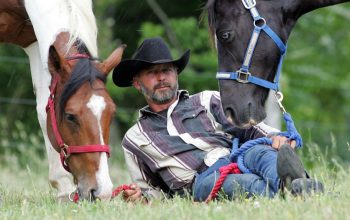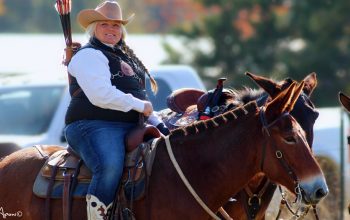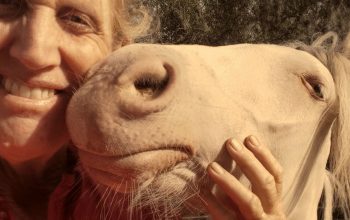By Mark Peterson
Have no fear! Encountering wildlife from horseback is why I ride. It’s what I live to do!

Wildlife will not harm you. Black Bear are what most people seem to be afraid of and they don’t realize that Black Bears are flight animals and not predatory. Wolves are predators, but we and our equine partners are not on their menu. Chances of encountering wolves are slim, but if you do, relish it! Wolf sightings are very rare because they always knew you were coming long before you see them, and flee.
Other than grizzly bears, there aren’t any animals in the wild that would typically pose a threat to humans, and especially not from horseback. Horses are very large, and even larger with a rider, and no wild animal wants to take on something that might injure them. An injured wild animal is usually a dead wild animal. If you live east of the Dakotas in the US, you will only encounter Black Bear, not Grizzly Bears.
If you encounter a mother Black Bear with cubs, have no fear. Mother Black Bears typically do not defend their young. Grizzly Bears on the other hand, are notorious for defending their cubs. When we tag Black Bears, we chase the cubs up a tree and the mother runs away and stands at a distance, even when we are pulling the cubs down from the tree to weigh them.
One of my favorite ways to view wildlife is riding my horse to the highest vantage point I can find. I then tie my horse and sit on the edge of a hill so I can view long distances. This allows me to see an animal in it’s own environment when it has no clue I’m there, at least initially. I always carry my binoculars with me so I can get a close up view of any wildlife I may come across.
Animal movements are relative to the weather and most significantly, the moon phase. But your best chance of seeing wildlife is at dawn and dusk, from sun up until about 9 AM and then the last two hours of daylight.

Some of my best wildlife photography is not taken with my big, long expensive lens and camera. Rather, a point and shoot pocket camera that is of high quality but easy to grab and shoot. Unless you are viewing wildlife at a long distance, when you encounter an animal from horseback, you’re lucky if you even get your hand in your pocket much less your big camera out to shoot. So I always ride with a point and shoot pocket camera that is extremely accessible at a moments notice.
Whenever you come across wildlife, you should never interfere. Let nature take it’s course no matter what you see. Many people have been injured or killed by trying to help a wild animal that only knows he is in trouble and fearing for his life.
The only animals that I have ever had anxiety toward have been moose. I have called moose all over North America during the rut. The bulls of course are rut crazy and only care about two things; breeding and fighting. Have caution!
Viewing wildlife from horseback is the best thing I can think of in life! It’s what I love to do most. Unless you are in Grizzly country, you and your horse have absolutely nothing to worry about when riding in wilderness areas. And according to those who ride out west, even Grizzlies avoid man on horseback. As for me, I think I’ll stick with Black Bear country!
This story originally appeared in the August 2016 issue of Sport and Trail Magazine
Learn more about Mark Peterson on his website > www.dustysadventures.com
Learn more about black bear expert, Dr. Lynn Rogers, at the Wildlife Research Institute in Ely, Minnesota > www.bearstudy.org




